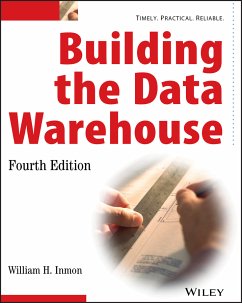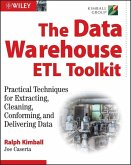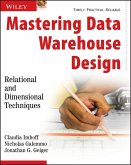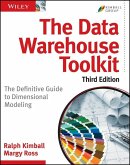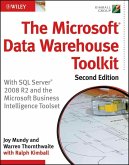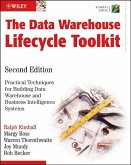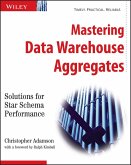Building the Data Warehouse (eBook, PDF)


Alle Infos zum eBook verschenken

Building the Data Warehouse (eBook, PDF)
- Format: PDF
- Merkliste
- Auf die Merkliste
- Bewerten Bewerten
- Teilen
- Produkt teilen
- Produkterinnerung
- Produkterinnerung

Hier können Sie sich einloggen

Bitte loggen Sie sich zunächst in Ihr Kundenkonto ein oder registrieren Sie sich bei bücher.de, um das eBook-Abo tolino select nutzen zu können.
* The new edition of the classic bestseller that launched the data warehousing industry covers new approaches and technologies, many of which have been pioneered by Inmon himself * In addition to explaining the fundamentals of data warehouse systems, the book covers new topics such as methods for handling unstructured data in a data warehouse and storing data across multiple storage media * Discusses the pros and cons of relational versus multidimensional design and how to measure return on investment in planning data warehouse projects * Covers advanced topics, including data monitoring and…mehr
- Geräte: PC
- mit Kopierschutz
- eBook Hilfe
- Größe: 10.63MB
![The Data Warehouse ETL Toolkit (eBook, PDF) The Data Warehouse ETL Toolkit (eBook, PDF)]() Ralph KimballThe Data Warehouse ETL Toolkit (eBook, PDF)36,99 €
Ralph KimballThe Data Warehouse ETL Toolkit (eBook, PDF)36,99 €![Mastering Data Warehouse Design (eBook, PDF) Mastering Data Warehouse Design (eBook, PDF)]() Claudia ImhoffMastering Data Warehouse Design (eBook, PDF)30,99 €
Claudia ImhoffMastering Data Warehouse Design (eBook, PDF)30,99 €![The Data Warehouse Toolkit (eBook, PDF) The Data Warehouse Toolkit (eBook, PDF)]() Ralph KimballThe Data Warehouse Toolkit (eBook, PDF)47,99 €
Ralph KimballThe Data Warehouse Toolkit (eBook, PDF)47,99 €![The Microsoft Data Warehouse Toolkit (eBook, PDF) The Microsoft Data Warehouse Toolkit (eBook, PDF)]() Joy MundyThe Microsoft Data Warehouse Toolkit (eBook, PDF)38,99 €
Joy MundyThe Microsoft Data Warehouse Toolkit (eBook, PDF)38,99 €![The Data Warehouse Lifecycle Toolkit (eBook, PDF) The Data Warehouse Lifecycle Toolkit (eBook, PDF)]() Ralph KimballThe Data Warehouse Lifecycle Toolkit (eBook, PDF)39,99 €
Ralph KimballThe Data Warehouse Lifecycle Toolkit (eBook, PDF)39,99 €![Mastering Data Warehouse Aggregates (eBook, PDF) Mastering Data Warehouse Aggregates (eBook, PDF)]() Christopher AdamsonMastering Data Warehouse Aggregates (eBook, PDF)50,99 €
Christopher AdamsonMastering Data Warehouse Aggregates (eBook, PDF)50,99 €![Corporate Information Factory (eBook, PDF) Corporate Information Factory (eBook, PDF)]() W. H. InmonCorporate Information Factory (eBook, PDF)50,99 €
W. H. InmonCorporate Information Factory (eBook, PDF)50,99 €-
-
-
Dieser Download kann aus rechtlichen Gründen nur mit Rechnungsadresse in A, B, BG, CY, CZ, D, DK, EW, E, FIN, F, GR, HR, H, IRL, I, LT, L, LR, M, NL, PL, P, R, S, SLO, SK ausgeliefert werden.
- Produktdetails
- Verlag: John Wiley & Sons
- Seitenzahl: 576
- Erscheinungstermin: 19. September 2005
- Englisch
- ISBN-13: 9780471774235
- Artikelnr.: 37347806
- Verlag: John Wiley & Sons
- Seitenzahl: 576
- Erscheinungstermin: 19. September 2005
- Englisch
- ISBN-13: 9780471774235
- Artikelnr.: 37347806
- Herstellerkennzeichnung Die Herstellerinformationen sind derzeit nicht verfügbar.
Acknowledgments xxvii
Chapter 1 Evolution of Decision Support Systems 1
The Evolution 2
The Advent of DASD 4
PC/4GL Technology 4
Enter the Extract Program 5
The Spider Web 6
Problems with the Naturally Evolving Architecture 7
Lack of Data Credibility 7
Problems with Productivity 9
From Data to Information 12
A Change in Approach 14
The Architected Environment 16
Data Integration in the Architected Environment 18
Who Is the User? 20
The Development Life Cycle 20
Patterns of Hardware Utilization 22
Setting the Stage for Re-engineering 23
Monitoring the Data Warehouse Environment 25
Summary 28
Chapter 2 The Data Warehouse Environment 29
The Structure of the Data Warehouse 33
Subject Orientation 34
Day 1 to Day n Phenomenon 39
Granularity 41
The Benefits of Granularity 42
An Example of Granularity 43
Dual Levels of Granularity 46
Exploration and Data Mining 50
Living Sample Database 50
Partitioning as a Design Approach 53
Partitioning of Data 53
Structuring Data in the Data Warehouse 56
Auditing and the Data Warehouse 61
Data Homogeneity and Heterogeneity 61
Purging Warehouse Data 64
Reporting and the Architected Environment 64
The Operational Window of Opportunity 65
Incorrect Data in the Data Warehouse 67
Summary 69
Chapter 3 The Data Warehouse and Design 71
Beginning with Operational Data 71
Process and Data Models and the Architected Environment 78
The Data Warehouse and Data Models 79
The Data Warehouse Data Model 81
The Midlevel Data Model 84
The Physical Data Model 88
The Data Model and Iterative Development 91
Normalization and Denormalization 94
Snapshots in the Data Warehouse 100
Metadata 102
Managing Reference Tables in a Data Warehouse 103
Cyclicity of Data - The Wrinkle of Time 105
Complexity of Transformation and Integration 108
Triggering the Data Warehouse Record 112
Events 112
Components of the Snapshot 113
Some Examples 113
Profile Records 114
Managing Volume 115
Creating Multiple Profile Records 117
Going from the Data Warehouse to the Operational Environment 117
Direct Operational Access of Data Warehouse Data 118
Indirect Access of Data Warehouse Data 119
An Airline Commission Calculation System 119
A Retail Personalization System 121
Credit Scoring 123
Indirect Use of Data Warehouse Data 125
Star Joins 126
Supporting the ODS 133
Requirements and the Zachman Framework 134
Summary 136
Chapter 4 Granularity in the Data Warehouse 139
Raw Estimates 140
Input to the Planning Process 141
Data in Overflow 142
Overflow Storage 144
What the Levels of Granularity Will Be 147
Some Feedback Loop Techniques 148
Levels of Granularity - Banking Environment 150
Feeding the Data Marts 157
Summary 157
Chapter 5 The Data Warehouse and Technology 159
Managing Large Amounts of Data 159
Managing Multiple Media 161
Indexing and Monitoring Data 162
Interfaces to Many Technologies 162
Programmer or Designer Control of Data Placement 163
Parallel Storage and Management of Data 164
Metadata Management 165
Language Interface 166
Efficient Loading of Data 166
Efficient Index Utilization 168
Compaction of Data 169
Compound Keys 169
Variable-Length Data 169
Lock Management 171
Index-Only Processing 171
Fast Restore 171
Other Technological Features 172
DBMS Types and the Data Warehouse 172
Changing DBMS Technology 174
Multidimensional DBMS and the Data Warehouse 175
Data Warehousing across Multiple Storage Media 182
The Role of Metadata in the Data Warehouse Environment 182
Context and Content 185
Three Types of Contextual Information 186
Capturing and Managing Contextual Information 187
Looking at the Past 187
Refreshing the Data Warehouse 188
Testing 190
Summary 191
Chapter 6 The Distributed Data Warehouse 193
Types of Distributed Data Warehouses 193
Local and Global Data Warehouses 194
The Local Data Warehouse 197
The Global Data Warehouse 198
Intersection of Global and Local Data 201
Redundancy 206
Access of Local and Global Data 207
The Technologically Distributed Data Warehouse 211
The Independently Evolving Distributed Data Warehouse 213
The Nature of the Development Efforts 213
Completely Unrelated Warehouses 215
Distributed Data Warehouse Development 217
Coordinating Development across Distributed Locations 218
The Corporate Data Model - Distributed 219
Metadata in the Distributed Warehouse 223
Building the Warehouse on Multiple Levels 223
Multiple Groups Building the Current Level of Detail 226
Different Requirements at Different Levels 228
Other Types of Detailed Data 232
Metadata 234
Multiple Platforms for Common Detail Data 235
Summary 236
Chapter 7 Executive Information Systems and the Data Warehouse 239
EIS - The Promise 240
A Simple Example 240
Drill-Down Analysis 243
Supporting the Drill-Down Process 245
The Data Warehouse as a Basis for EIS 247
Where to Turn 248
Event Mapping 251
Detailed Data and EIS 253
Keeping Only Summary Data in the EIS 254
Summary 255
Chapter 8 External Data and the Data Warehouse 257
External Data in the Data Warehouse 260
Metadata and External Data 261
Storing External Data 263
Different Components of External Data 264
Modeling and External Data 265
Secondary Reports 266
Archiving External Data 267
Comparing Internal Data to External Data 267
Summary 268
Chapter 9 Migration to the Architected Environment 269
A Migration Plan 270
The Feedback Loop 278
Strategic Considerations 280
Methodology and Migration 283
A Data-Driven Development Methodology 283
Data-Driven Methodology 286
System Development Life Cycles 286
A Philosophical Observation 286
Summary 287
Chapter 10 The Data Warehouse and the Web 289
Supporting the eBusiness Environment 299
Moving Data from the Web to the Data Warehouse 300
Moving Data from the Data Warehouse to the Web 301
Web Support 302
Summary 302
Chapter 11 Unstructured Data and the Data Warehouse 305
Integrating the Two Worlds 307
Text - The Common Link 308
A Fundamental Mismatch 310
Matching Text across the Environments 310
A Probabilistic Match 311
Matching All the Information 312
A Themed Match 313
Industrially Recognized Themes 313
Naturally Occurring Themes 316
Linkage through Themes and Themed Words 317
Linkage through Abstraction and Metadata 318
A Two-Tiered Data Warehouse 320
Dividing the Unstructured Data Warehouse 321
Documents in the Unstructured Data Warehouse 322
Visualizing Unstructured Data 323
A Self-Organizing Map (SOM) 324
The Unstructured Data Warehouse 325
Volumes of Data and the Unstructured Data Warehouse 326
Fitting the Two Environments Together 327
Summary 330
Chapter 12 The Really Large Data Warehouse 331
Why the Rapid Growth? 332
The Impact of Large Volumes of Data 333
Basic Data-Management Activities 334
The Cost of Storage 335
The Real Costs of Storage 336
The Usage Pattern of Data in the Face of Large Volumes 336
A Simple Calculation 337
Two Classes of Data 338
Implications of Separating Data into Two Classes 339
Disk Storage in the Face of Data Separation 340
Near-Line Storage 341
Access Speed and Disk Storage 342
Archival Storage 343
Implications of Transparency 345
Moving Data from One Environment to Another 346
The CMSM Approach 347
A Data Warehouse Usage Monitor 348
The Extension of the Data Warehouse across Different Storage Media 349
Inverting the Data Warehouse 350
Total Cost 351
Maximum Capacity 352
Summary 354
Chapter 13 The Relational and the Multidimensional Models as a Basis for
Database Design 357
The Relational Model 357
The Multidimensional Model 360
Snowflake Structures 361
Differences between the Models 362
The Roots of the Differences 363
Reshaping Relational Data 364
Indirect Access and Direct Access of Data 365
Servicing Future Unknown Needs 366
Servicing the Need to Change Gracefully 367
Independent Data Marts 370
Building Independent Data Marts 371
Summary 375
Chapter 14 Data Warehouse Advanced Topics 377
End-User Requirements and the Data Warehouse 377
The Data Warehouse and the Data Model 378
The Relational Foundation 378
The Data Warehouse and Statistical Processing 379
Resource Contention in the Data Warehouse 380
The Exploration Warehouse 380
The Data Mining Warehouse 382
Freezing the Exploration Warehouse 383
External Data and the Exploration Warehouse 384
Data Marts and Data Warehouses in the Same Processor 384
The Life Cycle of Data 386
Mapping the Life Cycle to the Data Warehouse Environment 387
Testing and the Data Warehouse 388
Tracing the Flow of Data through the Data Warehouse 390
Data Velocity in the Data Warehouse 391
"Pushing" and "Pulling" Data 393
Data Warehouse and the Web-Based eBusiness Environment 393
The Interface between the Two Environments 394
The Granularity Manager 394
Profile Records 396
The ODS, Profile Records, and Performance 397
The Financial Data Warehouse 397
The System of Record 399
A Brief History of Architecture - Evolving to the Corporate Information
Factory 402
Evolving from the CIF 404
Obstacles 406
CIF - Into the Future 406
Analytics 406
Erp/sap 407
Unstructured Data 408
Volumes of Data 409
Summary 410
Chapter 15 Cost-Justification and Return on Investment for a Data Warehouse
413
Copying the Competition 413
The Macro Level of Cost-Justification 414
A Micro Level Cost-Justification 415
Information from the Legacy Environment 418
The Cost of New Information 419
Gathering Information with a Data Warehouse 419
Comparing the Costs 420
Building the Data Warehouse 420
A Complete Picture 421
Information Frustration 422
The Time Value of Data 422
The Speed of Information 423
Integrated Information 424
The Value of Historical Data 425
Historical Data and CRM 426
Summary 426
Chapter 16 The Data Warehouse and the ODS 429
Complementary Structures 430
Updates in the ODS 430
Historical Data and the ODS 431
Profile Records 432
Different Classes of ODS 434
Database Design - A Hybrid Approach 435
Drawn to Proportion 436
Transaction Integrity in the ODS 437
Time Slicing the ODS Day 438
Multiple ODS 439
ODS and the Web Environment 439
An Example of an ODS 440
Summary 441
Chapter 17 Corporate Information Compliance and Data Warehousing 443
Two Basic Activities 445
Financial Compliance 446
The "What" 447
The "Why" 449
Auditing Corporate Communications 452
Summary 454
Chapter 18 The End-User Community 457
The Farmer 458
The Explorer 458
The Miner 459
The Tourist 459
The Community 459
Different Types of Data 460
Cost-Justification and ROI Analysis 461
Summary 462
Chapter 19 Data Warehouse Design Review Checklist 463
When to Do a Design Review 464
Who Should Be in the Design Review? 465
What Should the Agenda Be? 465
The Results 465
Administering the Review 466
A Typical Data Warehouse Design Review 466
Summary 488
Glossary 489
References 507
Articles 507
Books 510
White Papers 512
Index 517
Acknowledgments xxvii
Chapter 1 Evolution of Decision Support Systems 1
The Evolution 2
The Advent of DASD 4
PC/4GL Technology 4
Enter the Extract Program 5
The Spider Web 6
Problems with the Naturally Evolving Architecture 7
Lack of Data Credibility 7
Problems with Productivity 9
From Data to Information 12
A Change in Approach 14
The Architected Environment 16
Data Integration in the Architected Environment 18
Who Is the User? 20
The Development Life Cycle 20
Patterns of Hardware Utilization 22
Setting the Stage for Re-engineering 23
Monitoring the Data Warehouse Environment 25
Summary 28
Chapter 2 The Data Warehouse Environment 29
The Structure of the Data Warehouse 33
Subject Orientation 34
Day 1 to Day n Phenomenon 39
Granularity 41
The Benefits of Granularity 42
An Example of Granularity 43
Dual Levels of Granularity 46
Exploration and Data Mining 50
Living Sample Database 50
Partitioning as a Design Approach 53
Partitioning of Data 53
Structuring Data in the Data Warehouse 56
Auditing and the Data Warehouse 61
Data Homogeneity and Heterogeneity 61
Purging Warehouse Data 64
Reporting and the Architected Environment 64
The Operational Window of Opportunity 65
Incorrect Data in the Data Warehouse 67
Summary 69
Chapter 3 The Data Warehouse and Design 71
Beginning with Operational Data 71
Process and Data Models and the Architected Environment 78
The Data Warehouse and Data Models 79
The Data Warehouse Data Model 81
The Midlevel Data Model 84
The Physical Data Model 88
The Data Model and Iterative Development 91
Normalization and Denormalization 94
Snapshots in the Data Warehouse 100
Metadata 102
Managing Reference Tables in a Data Warehouse 103
Cyclicity of Data - The Wrinkle of Time 105
Complexity of Transformation and Integration 108
Triggering the Data Warehouse Record 112
Events 112
Components of the Snapshot 113
Some Examples 113
Profile Records 114
Managing Volume 115
Creating Multiple Profile Records 117
Going from the Data Warehouse to the Operational Environment 117
Direct Operational Access of Data Warehouse Data 118
Indirect Access of Data Warehouse Data 119
An Airline Commission Calculation System 119
A Retail Personalization System 121
Credit Scoring 123
Indirect Use of Data Warehouse Data 125
Star Joins 126
Supporting the ODS 133
Requirements and the Zachman Framework 134
Summary 136
Chapter 4 Granularity in the Data Warehouse 139
Raw Estimates 140
Input to the Planning Process 141
Data in Overflow 142
Overflow Storage 144
What the Levels of Granularity Will Be 147
Some Feedback Loop Techniques 148
Levels of Granularity - Banking Environment 150
Feeding the Data Marts 157
Summary 157
Chapter 5 The Data Warehouse and Technology 159
Managing Large Amounts of Data 159
Managing Multiple Media 161
Indexing and Monitoring Data 162
Interfaces to Many Technologies 162
Programmer or Designer Control of Data Placement 163
Parallel Storage and Management of Data 164
Metadata Management 165
Language Interface 166
Efficient Loading of Data 166
Efficient Index Utilization 168
Compaction of Data 169
Compound Keys 169
Variable-Length Data 169
Lock Management 171
Index-Only Processing 171
Fast Restore 171
Other Technological Features 172
DBMS Types and the Data Warehouse 172
Changing DBMS Technology 174
Multidimensional DBMS and the Data Warehouse 175
Data Warehousing across Multiple Storage Media 182
The Role of Metadata in the Data Warehouse Environment 182
Context and Content 185
Three Types of Contextual Information 186
Capturing and Managing Contextual Information 187
Looking at the Past 187
Refreshing the Data Warehouse 188
Testing 190
Summary 191
Chapter 6 The Distributed Data Warehouse 193
Types of Distributed Data Warehouses 193
Local and Global Data Warehouses 194
The Local Data Warehouse 197
The Global Data Warehouse 198
Intersection of Global and Local Data 201
Redundancy 206
Access of Local and Global Data 207
The Technologically Distributed Data Warehouse 211
The Independently Evolving Distributed Data Warehouse 213
The Nature of the Development Efforts 213
Completely Unrelated Warehouses 215
Distributed Data Warehouse Development 217
Coordinating Development across Distributed Locations 218
The Corporate Data Model - Distributed 219
Metadata in the Distributed Warehouse 223
Building the Warehouse on Multiple Levels 223
Multiple Groups Building the Current Level of Detail 226
Different Requirements at Different Levels 228
Other Types of Detailed Data 232
Metadata 234
Multiple Platforms for Common Detail Data 235
Summary 236
Chapter 7 Executive Information Systems and the Data Warehouse 239
EIS - The Promise 240
A Simple Example 240
Drill-Down Analysis 243
Supporting the Drill-Down Process 245
The Data Warehouse as a Basis for EIS 247
Where to Turn 248
Event Mapping 251
Detailed Data and EIS 253
Keeping Only Summary Data in the EIS 254
Summary 255
Chapter 8 External Data and the Data Warehouse 257
External Data in the Data Warehouse 260
Metadata and External Data 261
Storing External Data 263
Different Components of External Data 264
Modeling and External Data 265
Secondary Reports 266
Archiving External Data 267
Comparing Internal Data to External Data 267
Summary 268
Chapter 9 Migration to the Architected Environment 269
A Migration Plan 270
The Feedback Loop 278
Strategic Considerations 280
Methodology and Migration 283
A Data-Driven Development Methodology 283
Data-Driven Methodology 286
System Development Life Cycles 286
A Philosophical Observation 286
Summary 287
Chapter 10 The Data Warehouse and the Web 289
Supporting the eBusiness Environment 299
Moving Data from the Web to the Data Warehouse 300
Moving Data from the Data Warehouse to the Web 301
Web Support 302
Summary 302
Chapter 11 Unstructured Data and the Data Warehouse 305
Integrating the Two Worlds 307
Text - The Common Link 308
A Fundamental Mismatch 310
Matching Text across the Environments 310
A Probabilistic Match 311
Matching All the Information 312
A Themed Match 313
Industrially Recognized Themes 313
Naturally Occurring Themes 316
Linkage through Themes and Themed Words 317
Linkage through Abstraction and Metadata 318
A Two-Tiered Data Warehouse 320
Dividing the Unstructured Data Warehouse 321
Documents in the Unstructured Data Warehouse 322
Visualizing Unstructured Data 323
A Self-Organizing Map (SOM) 324
The Unstructured Data Warehouse 325
Volumes of Data and the Unstructured Data Warehouse 326
Fitting the Two Environments Together 327
Summary 330
Chapter 12 The Really Large Data Warehouse 331
Why the Rapid Growth? 332
The Impact of Large Volumes of Data 333
Basic Data-Management Activities 334
The Cost of Storage 335
The Real Costs of Storage 336
The Usage Pattern of Data in the Face of Large Volumes 336
A Simple Calculation 337
Two Classes of Data 338
Implications of Separating Data into Two Classes 339
Disk Storage in the Face of Data Separation 340
Near-Line Storage 341
Access Speed and Disk Storage 342
Archival Storage 343
Implications of Transparency 345
Moving Data from One Environment to Another 346
The CMSM Approach 347
A Data Warehouse Usage Monitor 348
The Extension of the Data Warehouse across Different Storage Media 349
Inverting the Data Warehouse 350
Total Cost 351
Maximum Capacity 352
Summary 354
Chapter 13 The Relational and the Multidimensional Models as a Basis for
Database Design 357
The Relational Model 357
The Multidimensional Model 360
Snowflake Structures 361
Differences between the Models 362
The Roots of the Differences 363
Reshaping Relational Data 364
Indirect Access and Direct Access of Data 365
Servicing Future Unknown Needs 366
Servicing the Need to Change Gracefully 367
Independent Data Marts 370
Building Independent Data Marts 371
Summary 375
Chapter 14 Data Warehouse Advanced Topics 377
End-User Requirements and the Data Warehouse 377
The Data Warehouse and the Data Model 378
The Relational Foundation 378
The Data Warehouse and Statistical Processing 379
Resource Contention in the Data Warehouse 380
The Exploration Warehouse 380
The Data Mining Warehouse 382
Freezing the Exploration Warehouse 383
External Data and the Exploration Warehouse 384
Data Marts and Data Warehouses in the Same Processor 384
The Life Cycle of Data 386
Mapping the Life Cycle to the Data Warehouse Environment 387
Testing and the Data Warehouse 388
Tracing the Flow of Data through the Data Warehouse 390
Data Velocity in the Data Warehouse 391
"Pushing" and "Pulling" Data 393
Data Warehouse and the Web-Based eBusiness Environment 393
The Interface between the Two Environments 394
The Granularity Manager 394
Profile Records 396
The ODS, Profile Records, and Performance 397
The Financial Data Warehouse 397
The System of Record 399
A Brief History of Architecture - Evolving to the Corporate Information
Factory 402
Evolving from the CIF 404
Obstacles 406
CIF - Into the Future 406
Analytics 406
Erp/sap 407
Unstructured Data 408
Volumes of Data 409
Summary 410
Chapter 15 Cost-Justification and Return on Investment for a Data Warehouse
413
Copying the Competition 413
The Macro Level of Cost-Justification 414
A Micro Level Cost-Justification 415
Information from the Legacy Environment 418
The Cost of New Information 419
Gathering Information with a Data Warehouse 419
Comparing the Costs 420
Building the Data Warehouse 420
A Complete Picture 421
Information Frustration 422
The Time Value of Data 422
The Speed of Information 423
Integrated Information 424
The Value of Historical Data 425
Historical Data and CRM 426
Summary 426
Chapter 16 The Data Warehouse and the ODS 429
Complementary Structures 430
Updates in the ODS 430
Historical Data and the ODS 431
Profile Records 432
Different Classes of ODS 434
Database Design - A Hybrid Approach 435
Drawn to Proportion 436
Transaction Integrity in the ODS 437
Time Slicing the ODS Day 438
Multiple ODS 439
ODS and the Web Environment 439
An Example of an ODS 440
Summary 441
Chapter 17 Corporate Information Compliance and Data Warehousing 443
Two Basic Activities 445
Financial Compliance 446
The "What" 447
The "Why" 449
Auditing Corporate Communications 452
Summary 454
Chapter 18 The End-User Community 457
The Farmer 458
The Explorer 458
The Miner 459
The Tourist 459
The Community 459
Different Types of Data 460
Cost-Justification and ROI Analysis 461
Summary 462
Chapter 19 Data Warehouse Design Review Checklist 463
When to Do a Design Review 464
Who Should Be in the Design Review? 465
What Should the Agenda Be? 465
The Results 465
Administering the Review 466
A Typical Data Warehouse Design Review 466
Summary 488
Glossary 489
References 507
Articles 507
Books 510
White Papers 512
Index 517
